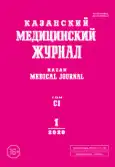The main arterial vessels of pancreatic isthmus and their importance in surgery
- Authors: Tarasenko SV1, Tarakanov PV1, Natalskiy AA1, Pavlov AV1, Dronova EA1
-
Affiliations:
- Ryazan State Medical University
- Issue: Vol 101, No 1 (2020)
- Pages: 53-57
- Section: Experimental medicine
- URL: https://bakhtiniada.ru/kazanmedj/article/view/19436
- DOI: https://doi.org/10.17816/KMJ2020-53
- ID: 19436
Cite item
Full Text
Abstract
Aim. To optimize the ways of cross-section of the pancreas in its isthmus, taking into account the topography of the main arteries of this area.
Methods. 43 organocomplexes representing pancreas with duodenum were studied. Injection mass was injected into arterial vessels with subsequent fixation in 4% formalin solution and final preparation of complexes. The main arteries of the isthmus of the pancreas, their places of origin and topography were evaluated.
Results. The main arteries of the isthmus of the pancreas are the peripancreatic artery and the additional artery of the isthmus of the pancreas. Peripancreatic artery was observed in 97.67% of cases; it departed from the dorsal pancreatic artery in 93% of cases, from the third branch of the splenic artery in 7% of cases. The diameter at the point of departure was 1.61±0.12 mm. In 95.3%, the artery passed along the lower edge of pancreatic isthmus. The peripancreatic artery was connected to the gastroduodenal artery or its branches. The diameter of peripancreatic artery at the junction was 1.55±0.1 mm. An additional artery of the isthmus of the pancreas was found in 93% of cases. In 76.74% it departed from the basin of the dorsal pancreatic artery, in 9.3% from another branch of the splenic artery, in 13.95% directly from the splenic artery itself. The diameter at the point of departure was 1.06±0.1 mm. It passed along the upper edge of pancreatic isthmus and connected to the pool of the gastroduodenal artery. The diameter at the junction was 0.98±0.1 mm. The diameter of peripancreatic artery was 1.95±0.05 mm in the trunk type versus 1.48±0.05 mm in the branched type of blood supply. The diameter of the additional artery of the isthmus of the pancreas had no pronounced changes depending on the type of blood supply to the pancreas.
Conclusion. The topography of the main arteries of the isthmus of the pancreas is constant and does not depend on their diameter and place of origin. The most vascularized zones of the isthmus of the pancreas are its lower and upper edges.
Keywords
Full Text
##article.viewOnOriginalSite##About the authors
S V Tarasenko
Ryazan State Medical University
Author for correspondence.
Email: lorey1983@mail.ru
Russian Federation, Ryazan, Russia
P V Tarakanov
Ryazan State Medical University
Email: lorey1983@mail.ru
Russian Federation, Ryazan, Russia
A A Natalskiy
Ryazan State Medical University
Email: lorey1983@mail.ru
Russian Federation, Ryazan, Russia
A V Pavlov
Ryazan State Medical University
Email: lorey1983@mail.ru
Russian Federation, Ryazan, Russia
E A Dronova
Ryazan State Medical University
Email: lorey1983@mail.ru
Russian Federation, Ryazan, Russia
References
- Busnardo A.C., Di Dio L.J.A., Thomford N.R. Anatomicosurgical segments of the human pancreas. Surg. Radiol. Anatomy: SRA. 1988; 10: 77–82. doi: 10.1007/BF02094076.
- Mosca S., Di Gregorio F., Regoli F. et al. The superior horizontal pancreatic artery of Popova: a review and an anatomoradiological study of an important morphological variant of the pancreatica magna artery. Surg. Radiol. Anatomy: SRA. 2014; 36: 1043–1049. doi: 10.1007/s00276-014-1276-8.
- Veronica M., Picardi E., Porzionato A. et el. Anatomo-radiological patterns of pancreatic vascularization, with surgical implications: Clinical and anatomical study. Clin. Anatomy (New York, N.Y.). 2017; 30 (5): 614–624. doi: 10.1002/ca.22885.
- Tarakanov P.V., Sudakova I.Yu., Pavlov A.V. Distinguishing features of the formation and topography of the pancreatic isthmus arterial trunks. Nauka molodykh (Eruditio Juvenium). 2018; 6 (2): 225–232. (In Russ.)
- Setdikova G.R., Paklina O.V., Shabunin A.V. et al. Morphological assessment of the prevalence of ductal adenocarcinoma of the pancreas. Rossiyskiy mediko-biologicheskiy vestnik imeni I.P. Pavlova. 2015; 23 (1): 130–136. (In Russ.)
- Schorn S., Demir I.E., Vogel T. et el. Mortality and postoperative complications after different types of surgical reconstruction following pancreaticoduodenectomy — a systematic review with meta-analysis. Langenbecks Arch. Surg. 2019: 404 (2): 141–157. doi: 10.1007/s00423-019-01762-5.
- Chen J.S., Liu G., Li T.R. et el. Pancreatic fistula after pancreaticoduodenectomy: Risk factors and preventive strategies. J. Cancer Res. Ther. 2019; 15 (4): 857–863. doi: 10.4103/jcrt.JCRT_364_18.
- Biondetti P., Fumarola E.M., Ierardi A.M. et el. Bleeding complications after pancreatic surgery: interventional radiology management. Gland. Surg. 2019; 8 (2): 150–163. doi: 10.21037/gs.2019.01.06.
- Kit O.I., Gevorkyan Ya.A., Maksimov A.Yu. et al. The outcomes of different pancreatodigestive anastomoses in pancreatoduodenectomy. Khirurgiya. 2016; (6): 43–46. (In Russ.)
- Sugimoto M., Takahashi S., Kobayashi T. et el. Pancreatic perfusion data and post-pancreaticoduodenectomy outcomes. J. Surg. Res. 2015; (2): 441–449. doi: 10.1016/j.jss.2014.11.046.
Supplementary files








